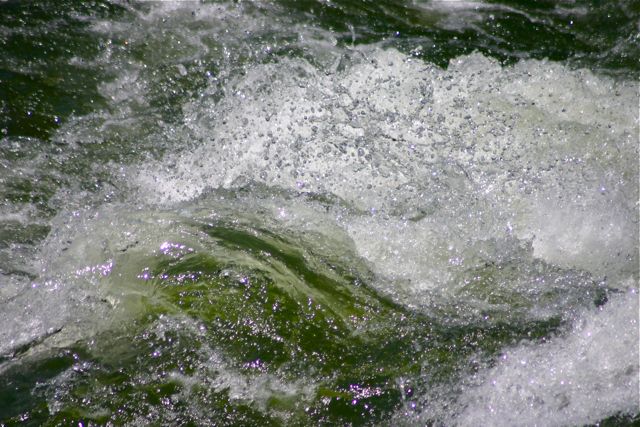Planned test site in Oregon could help answer the question, but will it survive Trump?

Staff Report
All eyes are on wind and solar these days, and rightly so, but ocean waves may play an even bigger role in humanity’s efforts to decarbonize energy production. Scientists and engineers in the Pacific Northwest may get a chance to show how that can happen with a new wave energy test facility in Newport, Oregon.
Last month, Oregon State University’s Northwest National Marine Renewable Energy Center today was awarded up to $40 million from the U.S. Department of Energy for the Pacific Marine Energy Center South Energy Test Site, which should be operational by 2020. It will be able to test wave energy “converters” that harness the energy of ocean waves and turn it into electricity. Companies around the world are already anticipating construction of the new facility to test and perfect their technologies, OSU officials say.
“We anticipate this will be the world’s most advanced wave energy test facility,” said Belinda Batten, the director of NNMREC and a professor in the OSU College of Engineering. The technologies are complex, she said. “These devices have to perform in hostile ocean conditions; stand up to a 100-year storm; be energy efficient, durable, environmentally benign – and perhaps most important, cost-competitive with other energy sources,” Batten said. “This facility will help answer all of those questions, and is literally the last step before commercialization.”
The DOE award is subject to appropriations, federal officials said today, and will be used to design, permit, and construct an open-water, grid-connected national wave energy testing facility. It will include four grid-connected test berths.
In making the award, the DOE noted that more than 50 percent of the U.S. population lives within 50 miles of coastlines, offering America the potential to develop a domestic wave energy industry that could help provide reliable power to coastal regions.
Investments in marine and hydrokinetic energy technology will encourage domestic manufacturing, create jobs, and advance this technology to help achieve the nation’s energy goals, DOE officials said in their announcement of this award. Studies have estimated that even if only a small portion of the energy available from waves is recovered, millions of homes could be powered.
The new facility and award also received support from a range of academic and political leaders:
Oregon U.S. Sen. Ron Wyden: “This is great news for OSU and its partners and will launch a new level of local job creation and clean energy innovation. Oregon will use this opportunity to build on its solid position nationally and internationally as a leader in renewable wave energy.”
Oregon U.S. Sen. Jeff Merkley: “This is a huge success story for Oregon State University, and I thank the Department of Energy for helping us harness the enormous potential of wave energy off the Oregon coast. This test facility will make Oregon the leader in bringing wave energy to the United States, which will create good-paying local jobs, and strengthen our coastal economies.”
Oregon U.S. Rep. Kurt Schrader: “Being able to tap into our rich marine energy resources will unleash the potential for billions of dollars in investment along our coastlines. The research that will be made possible through this grant is absolutely critical to the full and effective implementation of wave energy converters into the U.S. green energy portfolio. This federal support is terrific news for OSU and the entire local economy as it allows Oregonians to lead the pack here at home on wave energy.”
Oregon U.S. Rep. Suzanne Bonamici: “OSU is at the forefront of wave energy research. Wave energy has tremendous potential as a renewable resource to put our country on a path to a clean energy future. This critical federal support will allow the university, researchers, and students to continue to investigate and test the potential of wave energy. With this investment we are one important step closer to harnessing the power of the ocean to meet our nation’s clean energy needs, create good-paying jobs, and spur economic growth in our communities.”
Oregon Gov. Kate Brown: “I commend the talented team of Oregon State University researchers, staff, and students who lead the nation in research and development of wave energy technology. This U.S. Department of Energy grant announcement of up to $40 million leverages years of work and partnership with our state. This innovative work will contribute to Oregon and the nation’s clean energy mix of the future.”
Oregon State Sen. Arnie Roblan: “After the work of the coastal caucus during the 2016 session to secure a state match for this grant, I am pleased by this news. This grant will enable cutting edge research that will bring a variety of individual innovators to the Oregon coast. We are uniquely positioned to help the nation determine the efficacy of their energy devices to Oregon.”
Cynthia Sagers, vice president for research at OSU: “This award is a major win for Dr. Batten and her team. It comes after years of collaboration among OSU researchers, state and federal agencies, and industry partners. With it, we are one step closer to a clean, affordable and reliable energy future.”
Like wind farms, wave energy must be carefully located. Offshore Oregon is not a very good place because it’s a whale migration route and the whales can become entangled in the complex network of anchor lines required for wave energy modules. For visuals, see pages 7 and 8 here. http://ir.library.oregonstate.edu/xmlui/bitstream/handle/1957/36649/Lagerquist-graywhales.pdf;jsessionid=A287618FF0A82E3ED6193A22C1DFEECD